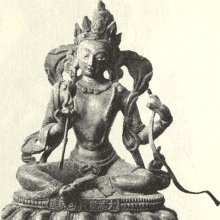Hai, Hāi: 10 definitions
Introduction:
Hai means something in Hinduism, Sanskrit, Jainism, Prakrit, Hindi, Tamil. If you want to know the exact meaning, history, etymology or English translation of this term then check out the descriptions on this page. Add your comment or reference to a book if you want to contribute to this summary article.
Images (photo gallery)
Languages of India and abroad
Sanskrit dictionary
Source: DDSA: The practical Sanskrit-English dictionaryHai (है).—ind. A vocative particle.
Source: Cologne Digital Sanskrit Dictionaries: Shabda-Sagara Sanskrit-English DictionaryHai (है).—Ind. 1. A vocative particle. 2. An interjection of calling. E. hve to call, ḍai aff.
Source: Cologne Digital Sanskrit Dictionaries: Benfey Sanskrit-English DictionaryHai (है).—A vocative particle.
Source: Cologne Digital Sanskrit Dictionaries: Cappeller Sanskrit-English DictionaryHai (है).—[adjective] vocative particle.
Source: Cologne Digital Sanskrit Dictionaries: Monier-Williams Sanskrit-English DictionaryHai (है):—ind. ([gana] svar-ādi) a vocative particle (used in calling or vociferating), [Atharva-veda; Taittirīya-brāhmaṇa etc.]
[Sanskrit to German]
Sanskrit, also spelled संस्कृतम् (saṃskṛtam), is an ancient language of India commonly seen as the grandmother of the Indo-European language family (even English!). Closely allied with Prakrit and Pali, Sanskrit is more exhaustive in both grammar and terms and has the most extensive collection of literature in the world, greatly surpassing its sister-languages Greek and Latin.
Hindi dictionary
Source: DDSA: A practical Hindi-English dictionary1) Hāī (हाई):—(a) high; —[korṭa] a high court; —[skūla] a high school.
2) Hai (है):—(v) is.
...
Prakrit-English dictionary
Source: DDSA: Paia-sadda-mahannavo; a comprehensive Prakrit Hindi dictionaryHai (है) in the Prakrit language is related to the Sanskrit word: Hati.
Prakrit is an ancient language closely associated with both Pali and Sanskrit. Jain literature is often composed in this language or sub-dialects, such as the Agamas and their commentaries which are written in Ardhamagadhi and Maharashtri Prakrit. The earliest extant texts can be dated to as early as the 4th century BCE although core portions might be older.
Kannada-English dictionary
Source: Alar: Kannada-English corpusHai (ಹೈ):—[noun] an indeclinable used in calling a person’s attention.
Kannada is a Dravidian language (as opposed to the Indo-European language family) mainly spoken in the southwestern region of India.
Tamil dictionary
Source: DDSA: University of Madras: Tamil LexiconHai (ஹை) . The compound of ஹ் [h] and ஐ. [ai.]
Tamil is an ancient language of India from the Dravidian family spoken by roughly 250 million people mainly in southern India and Sri Lanka.
See also (Relevant definitions)
Starts with (+268): Hai bai, Hai bin da ji, Hai bin shan li dou, Hai bin yi mu huan, Hai bing yi mu huan, Hai dai, Hai di ye, Hai dong, Hai er cao, Hai er cha, Hai er shen, Hai fu rong, Hai hong dou, Hai jin zi, Hai lan ci, Hai lian, Hai mian ji tai cao, Hai na, Hai nan cao shan hu, Hai nan di bu rong.
Ends with (+1764): A-yacitapiccai, Abashai, Abbashai, Abhai, Abhidhai, Acai, Acakkiratai, Acampatai, Acarappilai, Accai, Accavupatai, Acchai, Achai, Achchhai, Acirattai, Aciriyattalicai, Acitai, Acutai, Acuttai, Acuvattai.
Full-text (+224): Haikara, Hyhay, Hemavibhramasutra, Kitana, Hai tong, Haray-hai, Hai na, Ma hai, Haim, Haiga, Hai-kibi, Hai bai, Hai nan san qi, Zhou ye hai tong, Hai tong pi, Jia hai tong, Huang hai tang, Ghura, Shi hai jiao, Hai lian.
Relevant text
Search found 42 books and stories containing Hai, Haai, Hāī, Hāi; (plurals include: Hais, Haais, Hāīs, Hāis). You can also click to the full overview containing English textual excerpts. Below are direct links for the most relevant articles:
Tattvartha Sutra (with commentary) (by Vijay K. Jain)
Verse 7.3 - The five observances (bhāvanā) < [Chapter 7 - The Five Vows]
Verse 5.40 - The extent of the conventional time (vyavahāra-kāla) < [Chapter 5 - The Non-living Substances]
Yogadrstisamuccaya of Haribhadra Suri (Study) (by Riddhi J. Shah)
Chapter 2.3 - Date of Haribhadrasūri < [Chapter 2 - Life, Date and Works of Ācārya Haribhadrasūri]
Chapter 2.4 - Works of Haribhadrasūri < [Chapter 2 - Life, Date and Works of Ācārya Haribhadrasūri]
Chapter 2.2 - Life story of Haribhadrasūri < [Chapter 2 - Life, Date and Works of Ācārya Haribhadrasūri]
Preceptors of Advaita (by T. M. P. Mahadevan)
Sahitya-kaumudi by Baladeva Vidyabhushana (by Gaurapada Dāsa)
Text 4.66 < [Chapter 4 - First-rate Poetry]
Text 8.10 < [Chapter 8 - Literary Qualities]
Chaitanya Bhagavata (by Bhumipati Dāsa)
Verse 1.9.176 < [Chapter 9 - Nityānanda’s Childhood Pastimes and Travels to Holy Places]
Verse 2.8.269 < [Chapter 8 - The Manifestation of Opulences]
Verse 3.5.549 < [Chapter 5 - The Pastimes of Nityānanda]
The Unending Search < [April – June, July – September 1978]
Poet Iqbal's Dynamism < [October 1967]
The Only One < [March-April, 1930]
